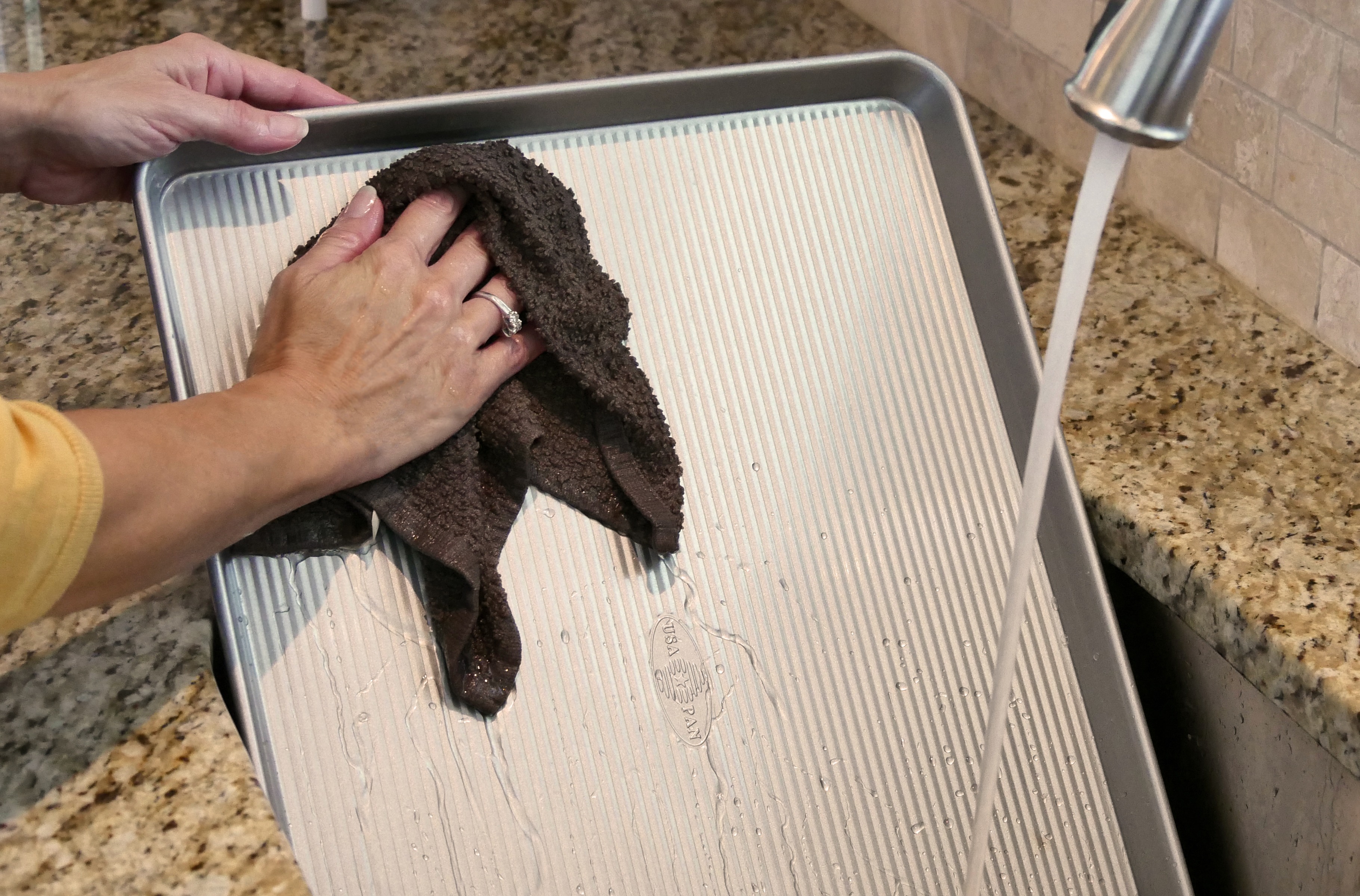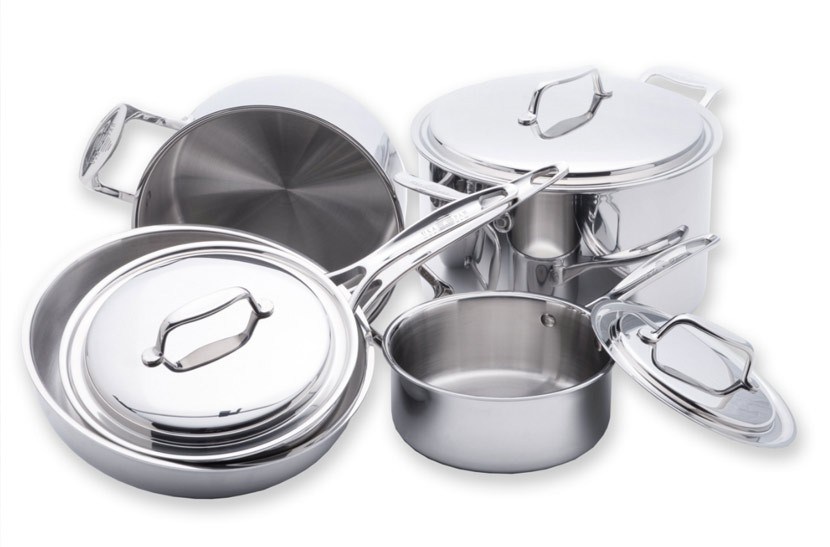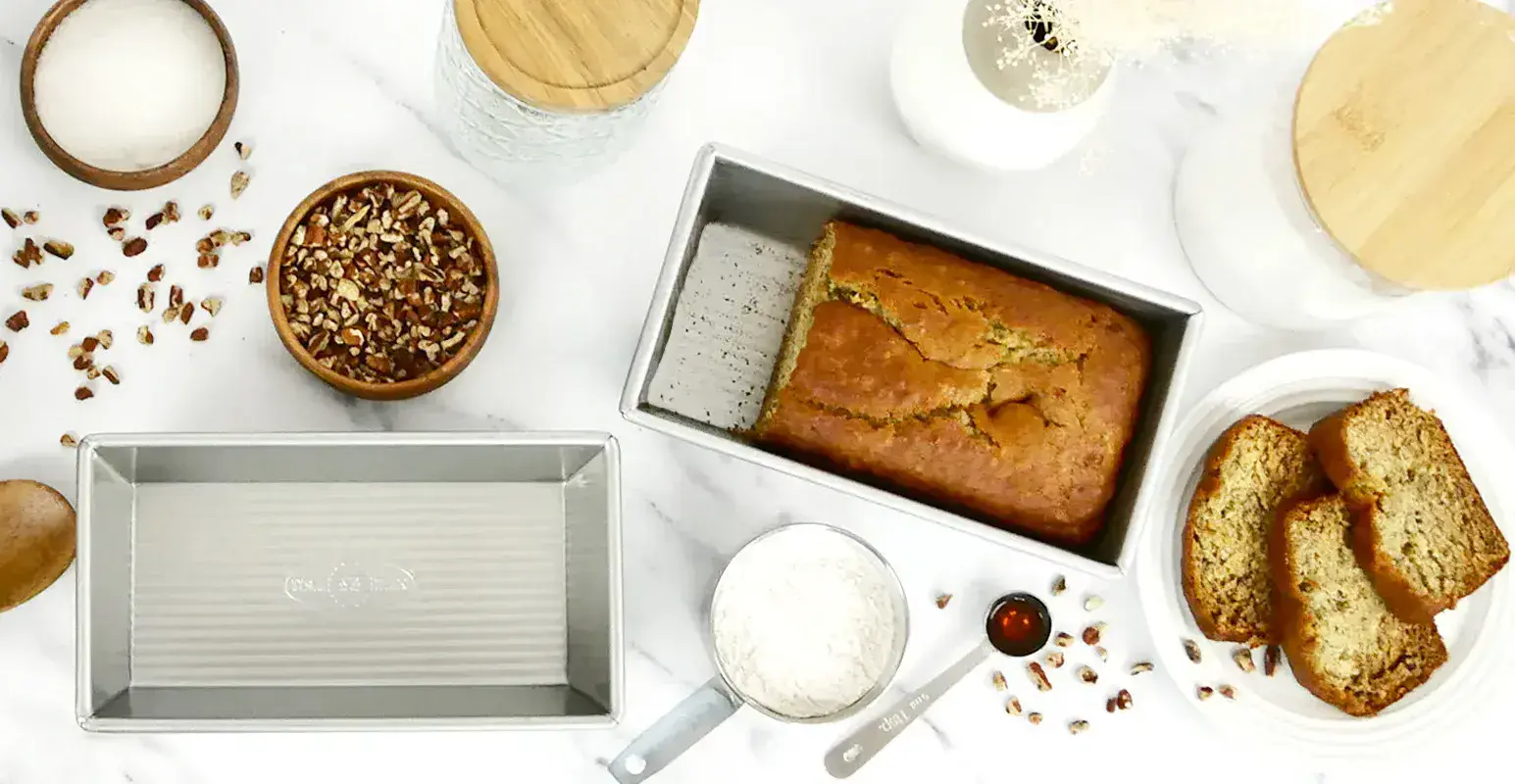USA Pan FAQ

Bakeware
How should I clean my USA Pan bakeware?
Gently scrub pans with a sponge or nylon pad, mild dishwashing soap, and warm water. Avoid using harsh abrasives or steel wool pads as this can harm the non-stick coating and shorten the life of the pan. (USA PAN bakeware has a non-stick coating that makes clean up easy and should not require vigorous scrubbing). Wash soon after every use to avoid staining and maintain appearance. Avoid cleaning with cola.
What coating does USA Pan use on their pans?
The coating applied on most USA PAN bakeware is Americoat™, our proprietary silicone release coating which is used on almost every commercial pan in North America. It is a natural non-stick and non-toxic silicone that is PTFE, PFOA, PFOS, PFAS and BPA free - including lead free. Americoat™ is clear in appearance and lets baked goods release quickly and effortlessly. Simply wipe the surface or wash with warm soapy water, and your USA PAN bakeware will last a lifetime.
How high of a temperature can I bake with my USA Pan bakeware?
The aluminized steel in USA PAN bakeware conducts heat efficiently; we recommend that you pay careful attention to oven temperatures and baking times the first few times you bake. Reduce time and temperature if necessary. Do not exceed 450º F because it could compromise the silicone coating.
What type of utensils should I use on my USA Pan items?
We recommend using silicone, wooden, or nylon utensils. Do not use sharp metal utensils to scrape food from the pan as this will chip the coating.
How is USA PAN bakeware measurements determined?
Our measurement dimensions are calculated by the baking surface of the pan. This means that the exterior panel is not included in the measurements that are provided.
How should I prepare my pan before use?
If you would like to grease or flour your pan before use, we recommend you follow recipe instructions. We do not recommend cooking sprays as they may stain your bakeware.
Does my USA PAN bakeware come with a warranty?
Yes, a lifetime warranty is supplied with every USA PAN bakeware product. Please reference our lifetime warranty page on our site (link to page).
How should I wash my USA PAN cooling rack?
Before use, wash cooling rack with warm, soapy water and use a soft sponge, nylon pan or hand towel to remove baked on goods. Avoid using harsh pads and abrasive cleaners. Dry thoroughly before storing.
Is my cooling rack oven safe?
Yes, all USA PAN cooling racks can be used to bake in all oven types. Our cooling racks are customized to fit perfectly in each of our individually sized sheet pans, including the extra large sheet pan, half sheet pan, jelly roll pan and quarter sheet pan.
What temperature can I bake with using my cooling rack?
Do not exceed 450º F because it could compromise the nonstick coating.
Why is USA PAN bakeware made with aluminized steel?
USA PAN is made with heavy duty aluminized steel, which is the material of choice for the professional baker. It offers superior heat transfer, strength, corrosion resistance, and durability. Most of the rims in our pans also incorporate steel wire to resist warping and to enhance pan strength.
Why does USA PAN bakeware have ridged surfaces?
USA PAN’s ridged, textured surface is a unique rib-like pattern that enhances baking by allowing air-flow under the baked good. This increased air circulation aids heat distribution throughout your recipe. It also reduces the surface contact between the pan and your baked goods allowing superior release.
What is a jelly roll pan?
The USA PAN jelly roll pan measures 14 ¼ x 9.38 x 1 inches and has one inch wired rims around all four sides. A jelly roll pan is a flat, rectangular sheet pan with raised sides that is a smaller version of a half sheet pan. In addition to dessert rolls and cookies, this pan is perfect for roasting vegetables.
How do I take care of my USA PAN Baking Mat?
Rinse before first use. Place baking mat on a sheet pan. Lay product to be baked or frozen on baking mat. Baking temperatures may need to be adjusted according to your oven. No greasing required. Store flat or rolled. Wipe the baking mat with a damp, soft sponge, then rinse with clean water. Shake to remove excess water and dry in open air. May be hand washed in warm water with mild dishwashing soap if needed. Note: the oily feeling after washing is normal, as is discoloration. Strong flavored foods may leave a trace scent on the baking mat.

Cookware
Is USA PAN cookware compatible on an induction stove?
Yes. USA PAN cookware can be used on all stove types including induction. USA PAN® cookware can also be used on cooking surfaces such as gas, electric, ceramic glass, and halogen.
How do I wash my USA PAN Cookware?
Before using USA PAN cookware for the first time, wash each piece thoroughly in mixture of hot soapy water and one-half cup vinegar. This will help to ensure that all manufacturing oils are removed. After initial use, wash as you normally would whether in a dishwasher or in hot soapy water.
How do I remove burned food from my USA PAN Cookware?
If you have food burnt in your pan, fill the pan with water (hot water for a hot pan and cold water for a cold pan). Soak until the burned areas easily lift off. If this doesn’t work, fill the pan with water, bring to a boil, and use a wooden spoon to remove the burned particles. For any remaining stains, remove with a non-abrasive stainless steel cleaner.
How can I remove a stain or discoloration after cooking?
First, wet the pan and remove excess water. Sprinkle with a good abrasive stainless steel cleaner. Then, using a paper towel or cloth, rub the cleaner over the stained area, rinse, and dry.
How do I maintain the shape of my USA PAN Cookware?
To resist warping, do not put cold water into a hot pan. Heat the pan gradually. Do not place an empty pan on high heat.
What is Vapor Seal Cooking?
USA PAN Cookware features a unique vapor seal that allows you to cook without water or grease. A vapor seal is created around the cover and heat is distributed evenly across the bottom and sides of the cookware. This process is nutritionally advantageous: it allows you to cook your food in its natural liquid for a healthier, flavor-filled meal. No need to add any moisture or fats.
How do I use the Waterless Cooking feature?
Use a pan that the food almost fills (Cooking with a pan too large for the food quantity can destroy vitamins and minerals, dry out foods, and possibly cause your food to burn). For fresh or frozen vegetables, rinse in cold water, drain most of the water and pour in your pan. For dried foods, such as rice, pasta, or dried beans, add some water. Cover the pan, place on a burner, and turn to medium heat. The vapor seal has formed when the lid is hot to the touch or vapor escapes around the lid and can be spun freely. Reduce heat to low and continue cooking until done. Resist the urge to peek: if the cover is removed during cooking, heat and moisture escapes and the vapor seal breaks. This lengthens cooking time. Follow time charts, recipes and general instructions for meats, vegetables, etc.
How do I use the Greaseless Cooking feature?
You may prepare your foods WITHOUT added oils and fats. Remember, you are cooking on a stainless steel surface. To prepare steaks, preheat the pan on medium to medium-high heat until water droplets "dance" when sprinkled on the pan. Place steaks in the pan. Take care in placing your steaks as they will immediately begin to sear, temporarily sticking to the surface. You should not move them until they are ready to turn. After 4-5 minutes try to lift a corner of your steak, but do not force it as the meat releases itself. When that side is seared, turn and cook to your steak preference.
To sauté onions and garlic, simply use medium-low heat and cover the pan — they sauté in their own moisture...no oil is needed. If olive oil is added, it's added for the flavor so often less is used. Most meats, chicken, chops, and fish have natural fats and oils, so you do not need to add them. Eggs have no natural oil — you need to spray the pan with vegetable cooking spray or use a small amount of butter or margarine.
Waterless-greaseless cooking is a low-temperature method that can be used on any type of stove. Lower heat retains moisture and keeps food from burning. The following are general rules for heat use.
MEDIUM-HIGH HEAT
- For heating the pan to brown or sear meat
- For re-moisturizing dried foods by steaming over water until the water boils
- For pan broiling thick steaks or chops (3/4" or thicker)
MEDIUM HEAT
- For pan broiling thin steaks, chops, hamburgers or chicken breasts
- For starting fresh fruits and vegetables until vapor seal forms
- To start direct top-of-range baking
LOW (OR SIMMERING) HEAT
- For cooking roasts after browning
- For cooking fresh vegetables and fruits after vapor seal forms
- For re-moisturizing dried foods by steaming over water after the water boils
- For cooking less tender cuts of meat after browning all sides
- For finishing top-of-range baking after pan cover is hot
